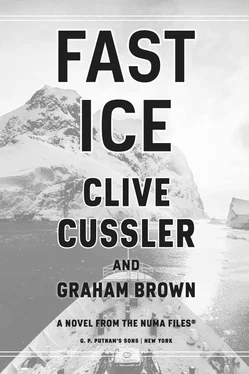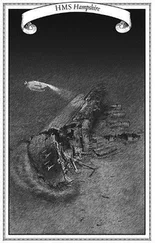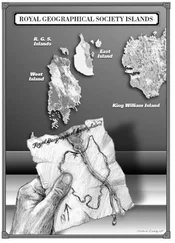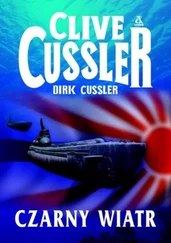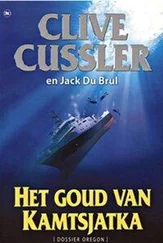“Roger,” Joe said. “Get us close and I’ll cut the power when you come up to the top of the next swell.”
Kurt activated the winch and the cable began to drag the helicopter downward. All Joe had to do was maintain side-to-side control and avoid a rotor strike if the ship tilted more than expected.
They rode one swell down and then up. By the time they began dropping into the next trough, the helicopter was only thirty feet above the deck. Kurt paused the winch as they dropped down, engaging it again as they came up the face of the next wave.
The helicopter moved closer . . . ten feet . . . five . . . three . . . Joe throttled back and the wheels of the Jayhawk touched down firmly, denting the temporary plating beneath them.
Kurt immediately pulled up the slack, pinning the helicopter tight to the deck. With the bear trap locked, he ran to the Jayhawk. He slid the side door open as Joe shut down the engine. “Make sure you set the parking brake,” he shouted.
“We’re going to need more than that if this storm gets worse,” Joe said.
“I have some straps to tie it down with,” Kurt said.
As Joe acknowledged Kurt with a wave, Paul and Gamay made for the exit. Gamay reached the door first. Kurt had never seen her look so green.
“You arranged this,” she said to Kurt. “I ought to throw up all over you.”
Kurt grinned and helped her step down. “I’m wearing rain gear that’s spent years being used in a fish processing bay. It couldn’t possibly smell any worse.”
Gamay’s nose wrinkled. “Oh, God,” she said, picking up the aroma. “That’s awful.”
She headed toward the bulkhead with a hand over her mouth.
Paul came down next. “At least you’ve gotten her mind off the terrible flight,” he said. “That’s something.”
With Paul and Gamay out of the aircraft, Joe flipped up the visor of his helmet. “You have no idea what I’ve been dealing with. While you’ve been out here on a pleasure cruise, I’ve been fighting against a passenger-led rebellion.”
“That’s not going to be the last storm-tossed flight for any of us,” Kurt said.
“How bad is it going to get?” Joe asked.
“Let me put it to you this way,” Kurt said. “There’s never been a hurricane over Antarctica. You and I might get to see the first.”
41
NUMA HEADQUARTERS
Rudi walked down a quiet hallway, passing empty offices and heading for the elevator. It was after midnight in Washington. Only a skeleton crew remained in the building, most of whom were camped out in the communications department, which ran twenty-four hours a day.
Taking the elevator up several floors, Rudi found Hiram Yaeger sitting behind a computer terminal with three separate screens in front of him. The first displayed lines of code, the second showed a number of graphs, while the third displayed a live satellite view over the South Pole.
“Glad to see I’m not the only one pulling an all-nighter,” Rudi said. “How’s it coming?”
“Depends what you’re referring to,” Yaeger replied. He turned in his seat. “If you mean the storm, it’s going swimmingly.”
“I have the forecast,” Rudi said, waving sheets of paper. “The storm is intensifying and continuing south. It’s being pushed by a ridge of high pressure right into Kurt’s lap.”
Yaeger nodded. “They’re not exactly sailing in a Class 5 cutter. You sure that rust bucket of a trawler will hold together?”
“I’m not sure at all,” Rudi said. “Which is why I need to make a go/no go decision rather soon. Is your ice age model ready to spit out a few answers?”
“More answers than you’re going to want,” Yaeger said.
Rudi got comfortable as Hiram checked through a few more lines of code and then initiated the program.
“We’re guessing at some of the parameters,” Yaeger said. “But based on Yvonne’s Snowball Earth dissertation and the claims Ryland made to his associates—which were, basically, mirrors of the truth—this is what it looks like.”
Hiram hit enter and the program started to run. On one screen a world map showed temperatures decreasing sequentially as sea ice increased and snow cover lingered. Hiram narrated the effects. “One year out, it’s nothing more than a harsh winter and a cool summer. But by year two the winter is bitter and months too long in both hemispheres and the summer heat never materializes. By year three, the summer ice pack stretches south of Greenland.”
Rudi saw the visual representation on the screen. The planet turning whiter from both poles toward the middle.
“By year five, a third of the world’s agriculture is being impacted by a shortened growing season. Hard frosts keep people from planting and seeds from germinating. All the fresh water locked up in snow and ice. That, along with less evaporation because of colder temperatures, makes for less rain and lower growth rates once the short growing season does arrive.”
Rudi studied the graphic representation of what Yaeger was telling him. He noted the three lines running close together through the first five years of the chart and then diverging at year five and widening substantially thereafter. “What are these lines?”
“Best-, average- and worst-case scenarios.”
“Give me the best case,” Rudi said.
“Worldwide temperature drops averaging twenty-four to thirty-nine degrees,” Yaeger said. “Canada, the northern U.S. and half of Europe end up in a frozen state akin to Siberia today. Much of Russia and northern China will become uninhabitable. A one-third drop in land-based food production by year ten, accompanied by a staggering eighty percent drop in catch rates and tonnage for sea-based food sources, caused mostly by overfishing as countries around the world attempt to make up the food deficit.”
“Mass starvation,” Rudi said. “That’s our best-case scenario?”
Yaeger nodded. “Even if we all stay in our frozen homelands, pile on the insulation and turn up the heat.”
As grim as that was, it was probably too good an outcome to hope for. “What’s the midline simulation looking like?”
“See for yourself,” Yaeger said. He tapped a button on the keyboard and the simulation resumed following the central plotline.
As Rudi watched, the permafrost crept down the map, slowly covering the United States until it reached south of Atlanta, Nashville and Dallas.
“Only Florida, southern Arizona and a thin sliver along the coasts will remain ice-free,” Yaeger explained. “Europe looks even worse. Everything north of Rome will be frozen tundra year-round. Only Portugal, parts of Spain and the southeast corners of the British Isles will escape and that’s only while what’s left of the Gulf Stream remains intact. It could easily die out.”
Rudi studied the map to see how other parts of the world would be affected. Most of China would be frozen solid, buried in rapidly accumulating snowfall and advancing glaciers. By year ten, Japan was connected to the mainland by ice sheets. By year twenty, those sheets extended halfway to the Aleutians.
South America would fare no better. Everything below Rio would look like Norway in winter. Only Africa was largely spared, though the southern third of the continent would have to endure long, harsh winters more like the climate in Alberta.
“I’m guessing snowdrifts will be quite a surprise to all the elephants, lions and crocodiles. No wonder Ryland bought all his land around the equator.”
Yaeger nodded. “He’s obviously run the simulation himself. His islands also remain in the liquid zone, even under this scenario. But even he can’t account for all the variables. Let me show you the third line. I call it the Doomsday Scenario.”
Читать дальше
